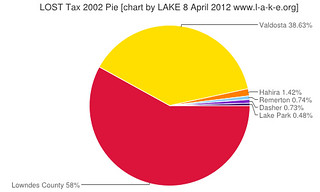Lowndes County Clerk Paige Dukes handed out this document, Lowndes County’s Report for Initial LOST Negotiations: April 9, 2012, at that first LOST meeting yesterday. When I spoke to her later, I mentioned that I thought it was the very model of how to write such a document: clear, complete, pithy, and easily understandable. She did not have a readily-accessible electronic copy, so I’ve posted these scanned images on the LAKE website.
The document includes a summary of the negotiation procedure (60 days to negotiate, after which it goes to mediation, then Superior Court “baseball arbitration”), plus how and how much LOST can reduce property taxes.
 The rest of the document is the county’s position, which includes that the county provides services such as sheriff, courts, public health, and animal control that benefit the entire county, and the county could claim 72% of LOST. However, the county is only asking for the same 58% as negotiated in 2002.
The rest of the document is the county’s position, which includes that the county provides services such as sheriff, courts, public health, and animal control that benefit the entire county, and the county could claim 72% of LOST. However, the county is only asking for the same 58% as negotiated in 2002.
A few things I did not know include that the dedicated millage for Parks and Rec (VLPRA 1.5mil) and the Industrial Authority (VLCIA 1 mil) come out of county property taxes, not out of any city property taxes. Also VLCIA’s millage started since 2002, before which VLCIA was funded out of hotel-motel taxes, including Valdosta hotel-motel taxes.
I also remarked to Paige Dukes that I wished the cities had prepared  similar position statements. She said they may be depending on LOST negotiating documents by the Georgia Municipal Association (GMA), and that there were similar documents by the Association of County Commissioners of Georgia (ACCG), both which you can find linked in on the LAKE website.
similar position statements. She said they may be depending on LOST negotiating documents by the Georgia Municipal Association (GMA), and that there were similar documents by the Association of County Commissioners of Georgia (ACCG), both which you can find linked in on the LAKE website.
The ACCG guidelines include this interesting passage:
Continue reading







